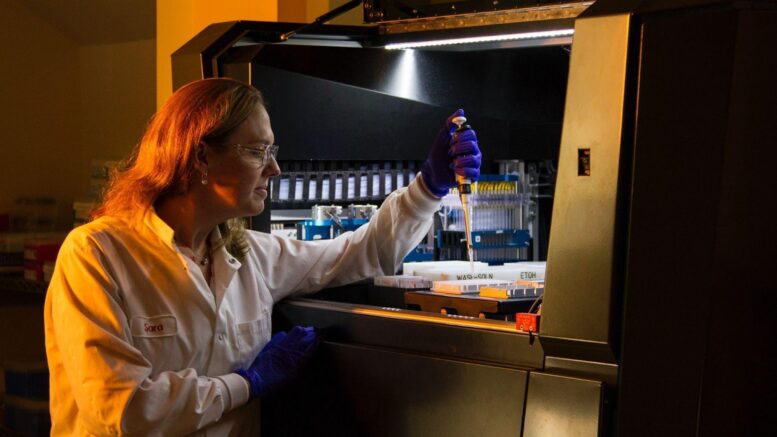According to PhRMA, an advocacy body that encourages the discovery of important, new medicines through public policy, it takes at least ten years for a new medicine to advance from drug discovery to approval. But Morgan Stanley predicts that machine learning and artificial intelligence (AI) will open new opportunities in drug development, potentially creating dozens of new medicines and increasing the global market for innovative pharmaceutical products by up to $50 billion. Morgan Stanley also says that to date, “much of the traditional process of discovering drugs is costly guesswork”.
The traditional process of drug discovery is changing thanks to new technology and methods of work in many different sectors. Innovations in AI and software that can leverage the benefits of massive amounts of data, as well as new technologies like quantum computing and gene writing, are changing the landscape for new drug discovery, reducing the costs of drug discovery and development, and helping to guide the search for new medicines in novel ways.
Gene Writing
CRISPR’s gene editing technology can help to alter the DNA inside of a cell, including deleting genes which can contribute to or cause illness. However, CRISPR isn’t as effective at replacing genes as it is at eliminating them. An emerging technology called gene writing is able to perform that task.
Tessera Therapeutics in Massachusetts is one of the startups developing gene writing techniques. Gene writing uses mobile genetic elements (MGEs) to perform gene engineering tasks. MGEs can use a DNA or an RNA copy of genetic code, and write and paste that code into a new genetic site. Gene writing can transcribe DNA from genomic origin sites. It can also transpose DNA from an MGE and paste it into another target site in a genome. And, the technique can also recombine DNA by directly exchanging MGE DNA from an original genetic site to another target genetic site. The technology is being investigated for potential benefits in rare genetic disorders like Huntington’s disease.
Quantum Computing

A 2021 report prepared by McKinsey & Company highlighted the potential that quantum computing could revolutionize the pharmaceutical industry’s development of molecular formulations. According to McKinsey, the molecules that are analyzed during drug development, whether they are small or large, all obey quantum systems.
Quantum computing (QC) is developing rapidly, and it is anticipated to much more accurately predict and model interactions on the atomic level within molecules. Amazon Web Services (AWS) offers an open-source solution for researchers to access quantum computers to evaluate experimental values in drug discovery. AWS’s Quantum Computing Exploration for Drug Discovery supports analysis of drug discovery problems, including protein folding and molecular docking.
Artificial Intelligence and Software
Nathan Brown (Director of Digital Chemistry at Healx) gave a 2020 overview of artificial intelligence’s role in drug discovery, highlighting ways that AI has already influenced drug discovery, especially in challenging areas like designing compounds and predicting Pharmacokinetic properties. AI can help with predictive modeling, molecular simulations, and synthesis planning.
A number of companies are developing AI and machine learning strategies to aid in drug discovery. Canadian startup Invivo AI incorporates representation and few-shot learning to aid in the drug discovery process.
Cerella, Optibrium’s AI-guided drug discovery software, can ‘fill in’ sparse data to highlight high-quality compounds. Cerella can also accurately predict complex endpoints that are impossible to model using conventional QSAR methods.
Other Emerging Innovations in Drug Discovery
Looking at real-world evidence (RWE) can be challenging in the face of hundreds of thousands, and even millions of medical records. A company in the United Kingdom, Pangaea Data, has developed an AI and machine learning software solution that can scan millions of electronic health records to produce broad-spectrum results and trend analysis.
Still in development, bioprinting holds tremendous potential to create tissue and organs for transplant and healing purposes. Some startups are developing bio-ink that can use the genes from a patient to create larger and more complex organs. One of the most promising uses for 3D-tissue printing is skin grafts with living skin and blood vessels for burn victims, which is in development at Rensselaer Polytechnic Institute. Several other types of engineered tissue have been created, but they do not include living blood vessels.
In-silico screening means biological experiments are conducted via computer simulations. This technology helps to develop products, without the need for testing on live subjects. In-silico screening is also beneficial to discover how some substances can be carcinogenic, and also in food toxicology testing.
Altogether, emerging technologies are fueling a renaissance in innovation in the pharmaceutical industry, which hasn’t been seen for many years. Looking to the future, these technologies seem to hold exciting innovations that could revolutionize the speed and effectiveness of aspects of the drug discovery industry.
